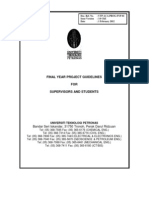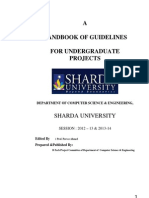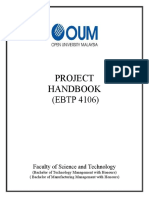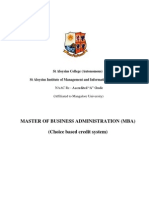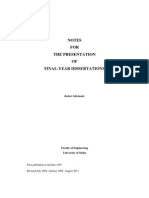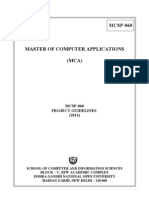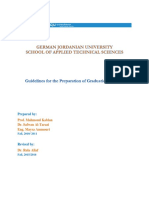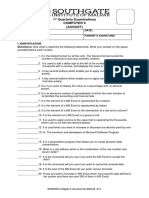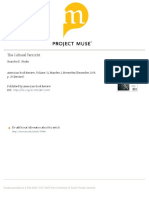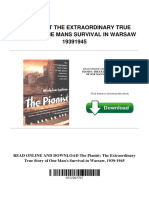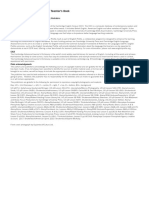Manual QSM 664
Manual QSM 664
Uploaded by
Muhammad GhazaliCopyright:
Available Formats
Manual QSM 664
Manual QSM 664
Uploaded by
Muhammad GhazaliOriginal Description:
Original Title
Copyright
Available Formats
Share this document
Did you find this document useful?
Is this content inappropriate?
Copyright:
Available Formats
Manual QSM 664
Manual QSM 664
Uploaded by
Muhammad GhazaliCopyright:
Available Formats
MANUAL FOR FINAL PROJECT/DISSERTATION (QSM664/QSB674)
Bachelor of Quantity Surveying (Hons.)
Dept. of Quantity Surveying, Faculty of Architecture, Planning & Surveying, UiTM
1.0
INTRODUCTION
The Final Project is in the form of a dissertation. It forms an integral part of the final year and is
an essential pre-requisite for the award of an Honours degree. This is one of the most
demanding intellectual exercises which are designed to enable students to carry out research
on their own chosen topic subject to approval by the Department. The course is a core course
offered in the final semester. However the process and preparation for the Final
Project/Dissertation starts in the fourth semester which include presentation and approval of
topic, formulation of objectives, scope and methodology, data gathering and analysis, etc.
under the supervision of the assigned supervisor.
The production of the Final Project commences with a preliminary study which may be in the
form of a literature survey, showing the conflict of evidence or opinion in previous work. This
preliminary study will be submitted in the form of an Interim Report in the middle of Semester
05 in order to monitor the progress of the students. The final stage involves the preparation of
analysis of the issues which the student will investigate, its findings, conclusion and
recommendations. Students should prepare a practical work program and adhere to it so that
the Final Project/Dissertation would be completed and submitted on time. The guide for
execution of the course is summarized in Table 1.
Table 1: The Execution of the Course
Activities Involved
Credit
Hours
Length of
Final Project
Semester 04:
Topic presentation
and approval
Research by
students
Mid Semester 05:
Submission of
Interim Report
Semester 06:
Course registration
and submission of
final draft of Final
Project /Dissertation
10,000 words
(minimum)
Consultation
Semester 04, 05 & 06:
Consultation
with supervisor
Fulfill min 6
times consultation
Assessors
Report
Bindings
Semester 05:
Supervisor
Final Draft:
Soft cover
Ring bound
Semester 06:
Supervisor and a
second assessor.
A third assessor
will be appointed
where the
difference in
marks given by
the two assessors
is 20 or more
Corrected
Final Project:
Hard cover
Hard bound
Colour:
Buckram
Maroon
MANUAL FOR FINAL PROJECT/DISSERTATION (QSM664/QSB674)
Bachelor of Quantity Surveying (Hons.)
Dept. of Quantity Surveying, Faculty of Architecture, Planning & Surveying, UiTM
1.1
Objectives
The objectives of the Final Project /Dissertation are to enable students to:
Work independently along the guidelines given by the Department.
Identify and analyze problems and recommend ways to overcome them.
Investigate and analyze data.
Demonstrate the understanding of all the relevant arguments.
Present findings in an effective report of professional standard (in the form of
dissertation).
1.2
Methods of Instruction
A brief lecture will be given to students on the methodology of carrying out the research writing
and the Departments guidelines on the presentation of the Final Project /Dissertation.
For the students own benefit, they are required to work independently by:
Reading texts on their chosen topics.
Going to site for academic visits.
Conducting interviews with relevant parties.
Preparing questionnaires to be distributed to relevant parties.
Students are required to propose topics for approval by the Department prior to commencing
the preparation of the Final Project /Dissertation.
1.3
Syllabus
Generally, the area of study covers any topics relevant to the betterment of the construction
industry as a whole and to the construction industry in Malaysia, in particular. The following are
possible list of research areas.
1.3.1
Law
Examples:
Contracts
Performance
Payment
Design
Sub-contracting
Risk allocation
Dispute resolution
MANUAL FOR FINAL PROJECT/DISSERTATION (QSM664/QSB674)
Bachelor of Quantity Surveying (Hons.)
Dept. of Quantity Surveying, Faculty of Architecture, Planning & Surveying, UiTM
1.3.2
Construction Economics
Examples:
Value Management
Risk Management
Economic Policy and the
Construction Industry
1.3.3
Labour market
Productivity
Macro-economic forecasting
Future construction output
Cost plans and life cycle
costings
Construction Technology
Examples:
New construction materials
New construction methods
1.3.4
Professional Practice
Examples:
Change and the development of the Profession
CPD/ Professionalism
1.3.5
Urban Policy
Examples:
Urban Regeneration
Planning Policy
Housing policy and renewal
1.3.6
Design and Human Factors
Examples:
Design Process
Human Factors
1.3.7
Energy and Building Conservation
Examples:
Technological Issues and Energy
The Human Dimension in Energy Efficiency
Energy Policy and Legislation
Conservation Technology
1.3.8
Procurement
Examples:
Design and Build
Construction Management
MANUAL FOR FINAL PROJECT/DISSERTATION (QSM664/QSB674)
Bachelor of Quantity Surveying (Hons.)
Dept. of Quantity Surveying, Faculty of Architecture, Planning & Surveying, UiTM
1.3.9
Management Contracting
Partnering
Management
Examples:
Project Management
Facilities Management
Construction Management
Value Management
1.3.10
Information Technology (IT)
Examples:
IT in Quantity Surveying
IT in the Construction Industry
2.0 FINAL PROJECT/DISSERTATION ORGANISATION STRUCTURE
The Final Project /Dissertation organization structure is given in Figure 1. The organization is
managed by a Coordinator.
DEPARTMENT OF
QUANTITY SURVEYING
Supervision
Coordinators
Evaluation
Supervisors
Students
Figure 1: Final Project /Dissertation Organization Structure
2.1 Coordinators
The Coordinators are appointed by the Head of Programme with the following
responsibilities:
a) Brief students on Final Project /Dissertation implementation.
b) Coordinate the process of topic approval.
4
MANUAL FOR FINAL PROJECT/DISSERTATION (QSM664/QSB674)
Bachelor of Quantity Surveying (Hons.)
Dept. of Quantity Surveying, Faculty of Architecture, Planning & Surveying, UiTM
c) Allocate students topics according to the supervisors expertise.
d) Coordinate the submission of the students Final Project /Dissertation (bound
copies).
e) Coordinate the evaluation process.
2.2 Supervisor
The roles of the supervisor are summarized below:a) Guide the formulation of the main objectives, scope and methodology of the
research.
b) Remind the students of the effects of copying, plagiarism and similar issues.
Originality of the Final Project /Dissertation work and report should be stressed.
c) Check and sign the students Consultation Form and ensure that the students
adhere to the Final Project /Dissertation schedule as well as deadlines required
by the department.
d) Assess the Interim Report and the Final Project /Dissertation.
The supervision by the supervisor does not relieve the student from his/her full
responsibility for the completion of the Final Project /Dissertation.
2.3 Students
Students shall register for the course at the start of semester 06. However, the
general preparation of the Final Project /Dissertation shall commence in semester 04,
during which they will submit their proposals. Students shall plan their work and
adhere to the Final Project /Dissertation schedule. Figure 2 shows the flowchart to
summarize tasks to be carried out by students.
The guidelines to be observed by students working on their Final Project /Dissertation
are as follows:a) Students shall provide a practical schedule to enable them to complete the report
by the due date.
b) Students shall record the progress of their work in the Consultation Form and
keep up to date with the standard format, requirements and deadlines of the
department. The Consultation Form shall be submitted to the Coordinator when
submitting the final draft.
MANUAL FOR FINAL PROJECT/DISSERTATION (QSM664/QSB674)
Bachelor of Quantity Surveying (Hons.)
Dept. of Quantity Surveying, Faculty of Architecture, Planning & Surveying, UiTM
Early
Semester
04
Briefing on Final Project /Dissertation
by the Coordinator
Topic proposal, approval and
appointment of supervisor
Prepare plan and schedule for implementation
of Final Project /Dissertation
Preparation
and
Submission
Middle Semester
05 (before midterm break)
Write up of Interim Report
Submit the Interim Report
Write up of Final Project /Dissertation
(Continuation from the Interim Report with
amendment)
Consultation with
supervisor
Interim Assessment by the
supervisor
Consultation with
supervisor
Submit draft to supervisor before the final
submission date
End of
Semester
06
Record
and
References
Final submission
(Submit three (3) ring bound Final
Project /Dissertation Report to Coordinator)
Submit the corrected Final Project
/Dissertation Report in hard bound to the
Coordinator for record and references
Assessment by
The Supervisor and Second
Assessor
MANUAL FOR FINAL PROJECT/DISSERTATION (QSM664/QSB674)
Bachelor of Quantity Surveying (Hons.)
Dept. of Quantity Surveying, Faculty of Architecture, Planning & Surveying, UiTM
Figure 2: Summary of the tasks to be carried out by students
3.0 FINAL PROJECT/DISSERTATION CALENDAR
Tables 2, 3 and 4 (a) present the calendar for semesters 04, 05 and 06. Table 4.0 (b) show the
checklist for the Coordinators
Table 2: Calendar for Semester 04
Week 1
Student
registration
Week 2
Briefing on
Final
Project
Week 8
Week 9
Week 3
Panels for
topic
presentation
will be
displayed
Week 10
Week 4
Presentation
of topic for
approval
Week 5
Week 6
Appointment
of
Supervisors
Week 7
Supervisor
List will be
displayed
Week 11
Week 12
Week 13
Week 14
Research
& writing up
Table 3: Calendar for Semester 05
Week 1
Student
registration
Week 2
Week 3
Week 4
Research
& writing up
Week 5
Week 6
Week 8
Week 9
Week 10
Week 11
Week 12
Week 13
Week 7
Submission
of Interim
Report
Week 14
Continue
Research
& writing up
Table 4 (a): Calendar for Semester 06
Week 1
Student
registration
Week 2
Week 3
Week 4
Week 8
Writing
In
Week 9
Submission
and
Week 10
Week 11
Week 5
Writing
in
progress
Week 12
Week 6
Week 7
Week 13
Week 14
MANUAL FOR FINAL PROJECT/DISSERTATION (QSM664/QSB674)
Bachelor of Quantity Surveying (Hons.)
Dept. of Quantity Surveying, Faculty of Architecture, Planning & Surveying, UiTM
Progress
Week 15
Assessment
Result
MANUAL FOR FINAL PROJECT/DISSERTATION (QSM664/QSB674)
Bachelor of Quantity Surveying (Hons.)
Dept. of Quantity Surveying, Faculty of Architecture, Planning & Surveying, UiTM
Table 4 (b): Checklist for the Coordinators
Department of Quantity Surveying
Semester 04
Semester 05
Week
1
Briefing to all Students
- Manual
- Process
- Procedure
To submit their particulars
Final Project/Dissertation (QSM664/QSB674)
Semester 06
Graduate student/ Semester 07
Coordinators:
To check with Administration
Assistant (AA) for the list of
Registered Students for
QSM664/QSB674
Final Date for Bound Copies
(3 copies + 1CD to Library) ,
Submission Form (signed and
stamped by Supervisor)
Students:
Register for QSM664/QSB674
To send Reminder to nonsubmission of Bound Copies & CD
2
3
Panels for Topic Selection
Presentation will be displayed
Topic Selection Presentation:
- Student will propose their topic
proposal to panel (QS Lecturers)
- If approved, immediately see
Supervision Coordinator to recheck approved topic. Bring
along the Topic Proposal form
that had been filled in by panel
- If not approved, need to reinterview
To Finalize the Final
Project/Dissertation Topic
Re-interview Panel
REMARKS
MANUAL FOR FINAL PROJECT/DISSERTATION (QSM664/QSB674)
Bachelor of Quantity Surveying (Hons.)
Dept. of Quantity Surveying, Faculty of Architecture, Planning & Surveying, UiTM
Table 4 (b): Checklist for the Coordinators
Department of Quantity Surveying
Semester 04
Semester 05
Week
-
To Finalize the Supervisor List
Supervisor List will be displayed
7
Students to Submit the
interim Report. Marks
allocation: 15%
Final Project/Dissertation (QSM664/QSB674)
Semester 06
Graduate student/ Semester 07
Class Representative:
- To submit details (name,
address, contact numbers
and email) to Evaluation
Coordinator
8
Submission of Final
Project/Dissertation Draft:
-
Submit with Consultation
Form(signed and stamp by
Supervisor)
(if less than 6x consultation =
reduction of marks)
Nonsubmission = FAIL
To Send the 2nd Copy to 2nd
Assessor
10
11
12
Feedback by Supervisor
Marks from the 1st & 2nd
Assessor Due (85%)
10
REMARKS
MANUAL FOR FINAL PROJECT/DISSERTATION (QSM664/QSB674)
Bachelor of Quantity Surveying (Hons.)
Dept. of Quantity Surveying, Faculty of Architecture, Planning & Surveying, UiTM
Table 4 (b): Checklist for the Coordinators
Week
Department of Quantity Surveying
Semester 04
Semester 05
Final Project/Dissertation (QSM664/QSB674)
Semester 06
Graduate student/ Semester 07
13
To 3rd Assessor (if difference of
marks more than 20 marks)
14
All Marks are to be finalized
LE15 due
15
Exam Result: To Send Letter /
call the Students for corrections
Students to make arrangement
with the Supervisor to collect
Final Report including
comments and to carry out
amendments if necessary
11
REMARKS
EXAM WEEK
MANUAL FOR FINAL PROJECT/DISSERTATION (QSM664/QSB674)
Bachelor of Quantity Surveying (Hons.)
Dept. of Quantity Surveying, Faculty of Architecture, Planning & Surveying, UiTM
4.0 CHOOSING THE FINAL PROJECT/DISSERTATION TOPIC
The following factors should be considered when choosing the Final Project /Dissertation topic
area:
1.
The student should be interested in the subject area to be
researched.
2.
The topic should be relevant to the area of the students future
professional work.
3.
The topic should be one in which the student can readily gain
access to the necessary data.
In order to decide on a suitable topic area for study, it is good for the student to spend time
looking at past final projects/ dissertations, news media, learned journals and published papers
from conferences and symposia. Themes from the students course work may be a useful
source of ideas. Problems encountered during industrial experience may also have aspects
which are worthy of investigation. It is also important that the topic chosen is specific with
clearly defined objectives and the title chosen should reflect the focal point and the area of
study.
The criteria to be used in the approval of a Final Project /Dissertation title will include the
following:
Is it related to the students own range of interest?
Is it related to the aims and objectives of the Programme?
Is it related to more than one of the subject areas of the Programme?
Does it combine an academic approach with some practical work?
Will it require original contribution from the student?
Are the resources required readily available?
5.0 THE TOPIC PROPOSAL
At the beginning of Semester 04, each student is required to propose his/her topic for approval
by the Department. Each student should present at least 3 topic proposals which should
include items as in Table 5 and Appendix 1.
12
MANUAL FOR FINAL PROJECT/DISSERTATION (QSM664/QSB674)
Bachelor of Quantity Surveying (Hons.)
Dept. of Quantity Surveying, Faculty of Architecture, Planning & Surveying, UiTM
The topic proposal will be presented to a panel of lecturers for approval. Students are not
allowed to change their topic without prior permission from the Department. Any changes to
the approved topic should be done before the end of Semester 04 and the application should
be made in writing to the Coordinator with recommendation from the supervisor.
Table 5: The Contents of Topic Proposal
TITLE
OVERVIEW OF THE
TITLE
AIM
OBJECTIVES
METHODOLOGY
A clear and concise statement of what is being proposed.
Provide a brief overview of the topic i.e. a statement which
says clearly what the Final Project /Dissertation will be about.
The student should also demonstrate how it relates to the
program.
Specify what the student is aiming to analyze, evaluate and test
in one sentence often in the form of what is to be investigated
(qualitative research) or what impact the main independent
variables are believed to have on the dependent variables
(quantitative research).
Between three and five single sentence objectives should be
developed as specific investigative elements which support the
overall aim.
This should explain
(i)
the sources of
data
(ii)
methods to be
adopted for collecting information and data; and
(iii)
the expected
methods of analyzing the data.
Etc. (as shown in Appendix 1)
6.0
FINAL PROJECT/DISSERTATION MANAGEMENT
6.1
Consultation
It is compulsory for students to keep a record of their consultation and the minutes of
the discussions with the supervisor. These record will have to be initialed by the
supervisor (refer to Appendix 2). The student should make regular consultations with
the supervisor. The Department requires the student to meet with the supervisor at
least six (6) times over the duration of the preparation of the Final
Project/Dissertation. The Department reserves the right to reject a final submission of
13
MANUAL FOR FINAL PROJECT/DISSERTATION (QSM664/QSB674)
Bachelor of Quantity Surveying (Hons.)
Dept. of Quantity Surveying, Faculty of Architecture, Planning & Surveying, UiTM
a student who does not fulfill the minimum consultation sessions with his/her
supervisor.
6.2
Collusion and Plagiarism
Plagiarism in oral, written or visual presentation is the presentation of the work, idea
or creation of another person, without appropriate referencing. Plagiarism is not
acceptable. The use of another persons works or ideas must be acknowledged.
The department reserves the right to implement procedures for academic misconduct
in cases where serious collusion/plagiarism occurs.
7.0
FINAL PROJECT/DISSERTATION STRUCTURE
The length of the Final Project/Dissertation report is about 10,000 to 15,000 words excluding
the abstract, content pages, appendices, tables, photos and diagrams. Editing work down to
the required length is one of the skills of report writing.
7.1
Title page
The title page needs to be expressive of the whole work and shall be as Appendix 3.
7.2
Declaration
The student must include the declaration form to confirm that the work is his/her own
and that appropriate credit has been given where reference has been made to the
work of others. The sample of the declaration form is as shown in Appendix 4.
7.3
Abstract and Keywords
Abstract to be included in the Final Project/Dissertation should not be more than 300
words and it should outline the topic, briefly state the aim, main objectives and
hypothesis (if applicable) summarize the methods of data collection and analysis and
state the main findings and conclusions. The sample of an abstract is as shown in
Appendix 5.
7.4
Acknowledgements
The acknowledgement page is the opportunity to include brief, formal statements of
thanks to people who have helped in the execution of the research; such as mentors,
14
MANUAL FOR FINAL PROJECT/DISSERTATION (QSM664/QSB674)
Bachelor of Quantity Surveying (Hons.)
Dept. of Quantity Surveying, Faculty of Architecture, Planning & Surveying, UiTM
supervisors, providers of data, editors, etc. Refer to Appendix 6 for the sample of
acknowledgement.
7.5
Table of Contents
The Final Project/Dissertation report must also include a Table of Contents, giving the
page numbers. The Table of Content page(s) needs to be a good guide of what
students have done. A glance at the contents page should give the assessor a very
clear idea of what the Final Project/Dissertation is about and what approach has been
taken.
7.6
Index
The Index should consist the following:
7.7
List of Figures
List of Tables
List of Abbreviations
Text of the report
The text of the report constitutes the bulk of the document. Although chapter
headings, sequences and breakdowns of contents will vary, a significant amount of
contents are `standard. The text will begin with an introductory chapter which will
discuss the topic of research, the rationale for the work, the aim and objectives, the
scope of study and research methodology. It may be helpful to end the introductory
chapter with a brief summary of the contents of the other chapters in the report, but
care should be taken that the brief summaries are not just repetitions of the contents
list.
The remaining content in the text of the report is likely to be written in a chronological
sequence in which the research was executed. The suggested order of writing the text
of the report is:
Introduction
Theory
Literature
Sampling and data collection
15
MANUAL FOR FINAL PROJECT/DISSERTATION (QSM664/QSB674)
Bachelor of Quantity Surveying (Hons.)
Dept. of Quantity Surveying, Faculty of Architecture, Planning & Surveying, UiTM
Presentation of results
-
Data analysis
Production of results
Discussion of results
Conclusions
Recommendations
Each chapter shall have its own title:
e.g.
7.8
CHAPTER 2 :
GLASS REINFORCED PLASTIC CLADDING
Figures/ Diagrams/ Photographs
These should be cross-referenced and placed appropriately within the main body of
the text to assist in the understanding of the text. Figures, diagrams, drawings and
photographs should all be described as Figures. Each figure/ diagram/ photograph
should have a title describing the contents and a figure number. The figures should be
consecutively numbered e.g. Figure 2.3 (third figure in Chapter 2). Example:
16
MANUAL FOR FINAL PROJECT/DISSERTATION (QSM664/QSB674)
Bachelor of Quantity Surveying (Hons.)
Dept. of Quantity Surveying, Faculty of Architecture, Planning & Surveying, UiTM
Figure 2.3: Floor heater stirring up dust in an enclosed cab
(Source: Technology, 2005)
Except in exceptional cases, all figures, diagrams, drawings and photographs should
not be larger than A4 size.
7.9
Tables
Tables should be cross-referenced and placed appropriately within the main body of
the text to assist in the understanding of the text. Each table should have a title
describing the contents and a table number. The tables should be consecutively
numbered, e.g. Table 3.1 (first table in Chapter 3). Example:
Table 3.1: Water velocities and hydraulic conductivities of the Lower Kittanning coal at the Kaufmann
site in Clearfield County, Pennsylvania, from slug tests, November 1991, and borehole dilution (BD)
tests, November 1992.
Well #
Velocity:
BD tests
Hydraulic
Conductivity:
BD tests (pe = 0.01)
Hydraulic
Conductivity:
BD tests (pe = 0.05)
Hydraulic
Conductivity:
slug tests
B2
0.054 ft/d
1.1 x 10-2 ft/d
0.054 ft/d
0.19 ft/d
B3
0.32 ft/d
0.07 ft/d
0.32 ft/d
8.9 x 10-3 ft/d
B4
0.06 ft/d
1.2 x 10-2 ft/d
6.0 x 10-2 ft/d
2.8 x 10-2 ft/d
7.10
List of Abbreviations
The list of abbreviations is a useful guide to ensure that both `standard and
`particular abbreviations are understood by all readers. All abbreviations used in the
report should be listed alphabetically with the full items noted against each
abbreviation.
7.11
Citation
The Final Project/Dissertation must be correctly cited or referenced. In the first place
this means avoiding the inadvertent appearance of plagiarism. In other words,
whenever a passage of the text relies for its argument upon one particular source,
that source must be acknowledged. There are few different styles or systems in citing
references eg. APA, MLA, Turabian, Havard, etc.). It is recommended to use the
Harvard system because of its flexibility, simplicity, clarity and ease of use both for
17
MANUAL FOR FINAL PROJECT/DISSERTATION (QSM664/QSB674)
Bachelor of Quantity Surveying (Hons.)
Dept. of Quantity Surveying, Faculty of Architecture, Planning & Surveying, UiTM
author and reader. There is no third place to look such as footnotes and chapter
references which are features of other systems.
Citing in the text
The Harvard system of citation is the most straightforward, because initially all the
students need to do is to mention the authors surname and publication year in the
text.
e.g.
According to Smith (1999), the types of risks in construction projects are divided into
environmental/ political, hazard/ safety, market and technical/ functional.
For direct quotations: need to identify the page numbers.
e.g. Project finance is the term used to describe the financing of a particular legal
entity, a project, whose cash flows and revenues will be accepted by the lender as a
source of funds from which the loan will be repaid (Smith, 1999 p.136).
For two authors
e.g.
Fellows & Liu (1997) mentioned that..
For more than two authors:
In the case of more than two authors, the first author followed by `et al, or `and
others.
e.g.
Matlock et al. (1996) has argued that
7.12
Conclusion
Conclusions are the major output of the research - what has been found out about the
topic under study through the execution of the research. As such, conclusions present
the major items and themes which have been raised and investigated. The conclusion
completes the story of the research from what it was desired to find out to what has
been found out. The conclusion should also include recommendations for further
study.
7.13
Appendices
18
MANUAL FOR FINAL PROJECT/DISSERTATION (QSM664/QSB674)
Bachelor of Quantity Surveying (Hons.)
Dept. of Quantity Surveying, Faculty of Architecture, Planning & Surveying, UiTM
Appendices may not include text written by the author, but may include material other
than text (e.g. copies of questionnaires, statistical tables and tests) and photocopies
of relevant materials not originated by the author.
7.14
References
Each Final Project/Dissertation report shall contain a References section (using the
Harvard systems) in which all works cited in the text are listed, in alphabetical order
of authors name, irrespective of the source of reference, as given below:
a) For books
Include the following information. The order is:
(1)
Author(s), editor(s) or the institution responsible for writing
the book.
(2)
Year of publication (in brackets).
(3)
Title and subtitle (if any) Underlined or Highlighted or in
Italics but must be consistent throughout the bibliography.
(4)
Series and individual volume number (if any)
(5)
Edition if not the first
(6)
Publisher
(7)
Place of publication if known
e.g.
Sawczuk, B. (1996), Risk avoidance for the building team, E & N Spon London.
Mohr, L.B. (1996), Impact analysis for program evaluation, 2nd ed., Sage, London.
b)
For theses and dissertations
Include the name of the awarding institution.
e.g.
Lim K. (2000) The valuation of hotels. Unpublished undergraduate dissertation,
Department of Real estate, National University of Singapore
Replace undergraduate with master or doctoral and dissertation with
thesis where appropriate.
c)
For conference/ seminar papers
e.g.
19
MANUAL FOR FINAL PROJECT/DISSERTATION (QSM664/QSB674)
Bachelor of Quantity Surveying (Hons.)
Dept. of Quantity Surveying, Faculty of Architecture, Planning & Surveying, UiTM
Dr Hamimah Adnan (2006) ` Malaysian Contractors Opinion Towards
International Market Expansion, June 2006, International Conference in Built
Environment, Kuala Lumpur
d)
For webpage
e.g.
PARN(2000), Continuing Professional Development (United Kingdom,
Professional
Associations
Research
Network),
Available:
st
http://www.parn.org.uk/uploads/cpd_res.pdf (Accessed: March 1 , 2001)
e)
For journals
Chapman, R.J. (2001) The controlling influences on effective risk identification
and assessment for construction design management, International Journal
of Project Management. Vol. 19 pp 147-160
Do not use numbers/bullets such as:
1) Sawczuk, B. (1996), Risk avoidance for the building team, E & N Spon London.
2) Mohr, L.B. (1996), Impact analysis for program evaluation, 2nd ed., Sage, London.
Or
7.15
Sawczuk, B. (1996), Risk avoidance for the building team, E & N Spon London.
Mohr, L.B. (1996), Impact analysis for program evaluation, 2nd ed., Sage, London.
Cover of the Final Project/Dissertation Report
The cover of the Final Project/Dissertation report shall follow the format in Appendix 7.
The particulars to be printed on the Final Project/Dissertation cover shall be of 18points Arial GOLD BLOCK FONT. The spine shall also be lettered in gold (direction of
text from head to foot), using 14-point font.
7.16
Formatting
The format of the report is given in Appendix 8.
7.17
Binding
The final copies must be bound in buckram maroon hard cover. Pages should be
permanently secured. The covers should be sufficiently rigid to support the weight of
the work when standing on shelf.
20
MANUAL FOR FINAL PROJECT/DISSERTATION (QSM664/QSB674)
Bachelor of Quantity Surveying (Hons.)
Dept. of Quantity Surveying, Faculty of Architecture, Planning & Surveying, UiTM
7.18
Paper and Duplication
Use quality plain white simile paper (80 gm) of A4 size (210mm x 297mm) for all three
(3) copies of the Final Project/Dissertation report for the submission. Duplicating of
pin-feed computer is not allowed. Only the original word-processed copy of a Final
Project/Dissertation or its good, clean and legible photocopies will be accepted.
7.0
SUBMISSION OF FINAL PROJECT/DISSERTATION
The Final Project/Dissertation must be handed in by the due date and time. Any submissions
after the due date will be deemed late. Late submissions will not be marked and will be given
a FAIL grade.
Exemptions from the above may be granted when permission for late submission has been
obtained prior to the due date or a serious illness has occurred provided that a medical
certificate is provided within seven (7) working days after the due date. Figure 3 shows the
flowchart for the submission and assessment of Final Project/Dissertation.
There are three (3) stages of submission of the Final Project/Dissertation:
(i)
Interim Report
To be submitted in the middle of Semester 05. The main purpose is to monitor
students progress. The content of the Interim Report is shown in Appendix 9.
(ii)
Final Draft
To be submitted at the end of Semester 06. The draft should be submitted in three (3)
copies in ring bound. One copy should be an original and the other two copies are
good quality photocopy.
(iii)
Hard bound Final Project/Dissertation
To be submitted after the assessment of the Final Project/Dissertation Draft. The
students should submit the corrected/amended Final Project/Dissertation report
based on the comments made by the assessors. The hard bound Final
21
MANUAL FOR FINAL PROJECT/DISSERTATION (QSM664/QSB674)
Bachelor of Quantity Surveying (Hons.)
Dept. of Quantity Surveying, Faculty of Architecture, Planning & Surveying, UiTM
Project/Dissertation must be submitted in three (3) copies with one soft copy in CD
(PDF format).
SEMESTER 03
Research Methodology (QSM 514)
SEMESTER 04
Topic Proposal
SEMESTER 05
Submission of Interim Report to Coordinator
Assessment and feedback by Supervisor
SEMESTER 06
Non-submission of Final
Project/Dissertation Draft on
stated date
Submission of Final Project/Dissertation Draft
and Consultation Form to Coordinator (Signed
and stamp by Supervisor)
(Ring bound copy)
RESU
LT
Assessment by Assessors
RESU
LT
Failed
Passed
> 50
Failed
(< 50 marks)
To make necessary
Amendments
Non Submission
of hard bound
SEMESTER 07
No
Second
Attempt?
22
Submission of hard bound
copy (Buckram Maroon)
and soft copy of Final
Project/Dissertation to the
Coordinator
MANUAL FOR FINAL PROJECT/DISSERTATION (QSM664/QSB674)
Bachelor of Quantity Surveying (Hons.)
Dept. of Quantity Surveying, Faculty of Architecture, Planning & Surveying, UiTM
Yes
Dismissal
(subject to
appeal)
Scroll will not be
issued
End
Re-register for the Course
End
To make necessary improvements
* Dismissal only if failed during 3rd attempt
Figure 3: Submission Procedure of Final Project/Dissertation
9.0
ASSESSMENT
The objective of evaluation on the Final Project/Dissertation is to determine the standard and
quality of the work. The Final Project/Dissertation which carries six (6) credit hours is assessed
in two stages i.e. in Semester 05 (Interim Report) and after the submission of the Final
Project/Dissertation Draft in Semester 06.
9.1
Interim Report assessment
The Interim Report assessment will constitute 15% of the overall mark for Final
Project/Dissertation. Marks will be awarded on the basis of overall assessment of
progress to date and the students approach to literature search, setting objectives
and planning of the Final Project/Dissertation. The Interim Report will only be
assessed by the supervisor. The marking scheme for this assessment is as per Form
1A in Appendix 10(a).
9.2
Final draft assessment
The assessment of the final draft of the Final Project/Dissertation will constitute 85%
of the overall mark. The mark will be determined on the basis of the content, analysis
and findings, conclusion and recommendations and overall presentation of the report.
The allocation for marks is as per Form 1B in Appendix 10(b). The Final
Project/Dissertation is assessed by the supervisor (first assessor) and a second
assessor. If the difference of marks between the supervisor (first assessor) and the
second assessor is 20 marks or more, a third assessor is appointed. The average of
the marks given by the third assessor and the marks given by the earlier assessors
which is nearer to the third assessors mark will be the final mark.
23
MANUAL FOR FINAL PROJECT/DISSERTATION (QSM664/QSB674)
Bachelor of Quantity Surveying (Hons.)
Dept. of Quantity Surveying, Faculty of Architecture, Planning & Surveying, UiTM
In the assessment of the Final Project/Dissertation report, high regard is given to clarity of
argument, knowledge of the field and analytical rigor. The work may be considered
unacceptable due to lack of structure, a disorganized or poorly framed argument, description
rather than analysis, superficiality and poor presentation. The grade awarded would normally
reflect the following attributes:
i.
Grade A (Excellent)
A+ = 90-100
A = 80-89
A- = 75-79
Objectives of the study clearly specified.
Displays understanding in the choice and use of date collection
method
High level in analysis of data collected.
Provides a comprehensive and critical analysis of the
methodological strengths and limitations of the study.
Comprehensive review of literature and critical analysis of key
issues.
Sustains logical argument and original ideas in both main text
and conclusions.
Thoughtful and reflective in making recommendations.
Lucidly, concisely and accurately written.
Presentation visually stimulating.
ii.
Grade B (Good)
B+ = 70-74
B = 65 69
B- = 60-64
Objectives of the study clearly stated.
Displays understanding in selection of methods of data collection.
Appropriate methods of data analysis selected.
Comprehensive review of the literature and critical analysis of key issues.
Cogent, well balanced argument put forward.
24
MANUAL FOR FINAL PROJECT/DISSERTATION (QSM664/QSB674)
Bachelor of Quantity Surveying (Hons.)
Dept. of Quantity Surveying, Faculty of Architecture, Planning & Surveying, UiTM
Appropriate conclusions drawn and recommendations made.
Concisely and accurately written.
Demonstrates good presentation skills.
iii.
Grade C (Pass)
C+ = 55-59
C = 50-54
Objectives of study clear.
Limited choice of data collection methods.
Adequate analysis of the strengths and limitations of the study.
Wide range of the literature, key issues identified.
Adequate analysis of findings.
Logical argument advanced.
Appropriate conclusions drawn and recommendation made.
Accurately written.
Well presented.
iv.
Grade C- (Fail)
C- = 47-49
Field of enquiry and objectives of study not clearly stated.
Limited selection and use of data collection methods.
Superficial analysis of the strengths and limitations of the study.
Limited review of relevant literature.
Superficial analysis of data.
Limited conclusions drawn and recommendations made.
Competent writing skills.
Adequate presentation of materials.
v.
Grade D to E (Bad Fail)
D+ = 44-46
D = 40 43
E = 30-39
25
MANUAL FOR FINAL PROJECT/DISSERTATION (QSM664/QSB674)
Bachelor of Quantity Surveying (Hons.)
Dept. of Quantity Surveying, Faculty of Architecture, Planning & Surveying, UiTM
Field of enquiry and objectives of study unclear.
Inappropriate choice of data collection methods.
Limited analysis of the strengths and limitations of the study.
Limited acquaintance with the literature appropriate to the chosen topic.
Limited analysis of data.
Superficial argument, lacking in structure.
Poor writing skills.
Inadequate presentation of materials.
Students who failed the Final Project/Dissertation must re-register for the Course in the
following semester and to make necessary amendment and improvement on their report based
on comments made by the supervisor and the second assessor. The maximum mark for a
second attempt is only Grade C (50%).
10.0
CONCLUSION
The Final Project/Dissertation undertaken by the students demands a regimented, diligent and
intellectual exercise. This entails the students, amongst others, to identify a research area,
determine the aim and objectives of the research, conduct a comprehensive literature review
and analysis of critical issues, understand the choice and use of appropriate methods and tools
for data collection and analysis, develop the ability to communicate logical arguments and
original ideas, be thoughtful and effective in making conclusions and recommendations, and
finally, present the findings concisely and accurately in an effective report of a professional
standard, in the form of dissertation.
In the process, the students are trained to be organized, to work independently, and ultimately,
they will acquire the relevant skill, experience and knowledge on the construction industry, in
general, and aspects of quantity surveying, in particular.
26
You might also like
- Anya's GhostDocument16 pagesAnya's GhostAshlee Garland4% (57)
- Intervals Ma Between Time Space Richard PilgrimDocument24 pagesIntervals Ma Between Time Space Richard PilgrimAlessandra Francesca100% (1)
- BQ FencingDocument4 pagesBQ FencingMuhammad Ghazali88% (8)
- Yoga and Health, Harmony Publishing, 2009: DownloadDocument23 pagesYoga and Health, Harmony Publishing, 2009: DownloadAhmed Amine HamzaouiNo ratings yet
- Log BookDocument17 pagesLog BookSatya NarayanaNo ratings yet
- The Project Manager's Checklist for Building Projects: Delivery Strategies & ProcessesFrom EverandThe Project Manager's Checklist for Building Projects: Delivery Strategies & ProcessesNo ratings yet
- Integrated Project Planning and Construction Based on ResultsFrom EverandIntegrated Project Planning and Construction Based on ResultsNo ratings yet
- BQ SewerageDocument3 pagesBQ SewerageMuhammad Ghazali100% (1)
- Transgressing The BoundariesDocument4 pagesTransgressing The Boundariesschooletc100% (1)
- To The LighthouseDocument4 pagesTo The LighthousegeorgelxNo ratings yet
- Mozart-The-Jupiter-Symphony (By Elaine Sisman)Document128 pagesMozart-The-Jupiter-Symphony (By Elaine Sisman)Leung Chi-hin100% (4)
- Hanbook Project Xbtp4106 BohsmDocument28 pagesHanbook Project Xbtp4106 BohsmVinodhan AyakannoNo ratings yet
- 30123632CBBR4106 Project GuidelineDocument32 pages30123632CBBR4106 Project GuidelineIyatieku SF100% (1)
- Project Boshm (Word) - 4-Hanbook - Project - xbtp4106 - BohsmDocument29 pagesProject Boshm (Word) - 4-Hanbook - Project - xbtp4106 - BohsmSureskumarMariskrishanan100% (1)
- Fyp Guidelines 2012 MasterDocument67 pagesFyp Guidelines 2012 MasterMuhammadFaiqRosliNo ratings yet
- Project_Guideline-2022Document10 pagesProject_Guideline-2022RakeshNo ratings yet
- Thesis GuidelinesDocument3 pagesThesis GuidelinesAr Vishnu PrakashNo ratings yet
- The Architectural Graduation ProjectDocument6 pagesThe Architectural Graduation ProjectAmal AhmadNo ratings yet
- UPM A Guide To Student ProjectDocument14 pagesUPM A Guide To Student ProjectRobert RobinsonNo ratings yet
- E - Fyp GuidelinesDocument71 pagesE - Fyp GuidelinesArif AzizanNo ratings yet
- FYP1 Student & Supervisor Guide (02092015) UitmDocument32 pagesFYP1 Student & Supervisor Guide (02092015) UitmHaziq JamaludinNo ratings yet
- Fyp Guidelines Log BookDocument48 pagesFyp Guidelines Log BookChristyNo ratings yet
- 20._M.E-welding-engineeringDocument50 pages20._M.E-welding-engineeringpbujairNo ratings yet
- Doctoral Degree in Civil and Environmental EngineeringDocument15 pagesDoctoral Degree in Civil and Environmental EngineeringThema ArrisaldiNo ratings yet
- Guidelines For Project ReportDocument27 pagesGuidelines For Project ReportShakaib IftikharNo ratings yet
- Project Guidelines BTech (Scheme A) Mechanical EnggDocument14 pagesProject Guidelines BTech (Scheme A) Mechanical Enggomharale5353No ratings yet
- Unibz SET 33cycle enDocument5 pagesUnibz SET 33cycle enRamiz KurbegovicNo ratings yet
- Guidelines Study ProjectDocument2 pagesGuidelines Study ProjectJoaquim Verissimo JuniorNo ratings yet
- Final Year Project FormatDocument36 pagesFinal Year Project Formatadityakr2410No ratings yet
- Course Syllabus For CSS 595: Capstone Project Winter 2012Document5 pagesCourse Syllabus For CSS 595: Capstone Project Winter 2012Ako Si JhadongNo ratings yet
- Course Outline - EnGR 301Document7 pagesCourse Outline - EnGR 301darwinNo ratings yet
- 1-Hanbook - Project - Ebtp4106 - BTM & BMMG & BPFMDocument23 pages1-Hanbook - Project - Ebtp4106 - BTM & BMMG & BPFMSuwit HannieNo ratings yet
- Mpu4 (Students Guidelines) May - September 2016 - Batch 2Document17 pagesMpu4 (Students Guidelines) May - September 2016 - Batch 2Hanafi HasbiNo ratings yet
- Mba New SyllabusDocument229 pagesMba New Syllabuskirankumar_snNo ratings yet
- Mcom Syllabus Calicut 2015Document65 pagesMcom Syllabus Calicut 2015lakshmananmpNo ratings yet
- MSC BSE Course Guide 13 - 14 PDFDocument0 pagesMSC BSE Course Guide 13 - 14 PDFKamran KhanNo ratings yet
- Project Guidelines 2011Document31 pagesProject Guidelines 2011Russell FarrugiaNo ratings yet
- 17.M.E Thermal Power EngineeringDocument69 pages17.M.E Thermal Power EngineeringBarath kumaranNo ratings yet
- LLB Final Project Instructions 1Document19 pagesLLB Final Project Instructions 1virendralodhi1990No ratings yet
- M.tech Project GuidelinesDocument5 pagesM.tech Project Guidelinesaravindsnist100% (1)
- CEE - Doc.Prog .Guide .4.21.20 PDFDocument13 pagesCEE - Doc.Prog .Guide .4.21.20 PDFAvatarIngenieroNo ratings yet
- Fyp Guidelines v9 May2013Document17 pagesFyp Guidelines v9 May2013Ifkar AzmiNo ratings yet
- Graduation Project Guide (GPG) : September 2015Document25 pagesGraduation Project Guide (GPG) : September 2015abdullah 3mar abou reashaNo ratings yet
- Instr - Dissertation MBA (Professional) 19Document4 pagesInstr - Dissertation MBA (Professional) 19Kazi Rabbi Al AzizNo ratings yet
- Handbook 2011/2012: Department of Electrical and Electronic EngineeringDocument29 pagesHandbook 2011/2012: Department of Electrical and Electronic EngineeringBhuvanesh Babu BharathiNo ratings yet
- Final Year Project GuidelinesDocument10 pagesFinal Year Project GuidelinesBright MuzaNo ratings yet
- PG Phase 1 Report FormatDocument24 pagesPG Phase 1 Report FormatRaja Mala Harinika0% (1)
- S12016 FYP1 BriefingDocument27 pagesS12016 FYP1 BriefingHari PrasathNo ratings yet
- MBA - 2nd Year Banking Finance Services 2023-24 - V3Document38 pagesMBA - 2nd Year Banking Finance Services 2023-24 - V3Rahul KumarNo ratings yet
- National Engineering College: Rules and Regulations - 2011Document21 pagesNational Engineering College: Rules and Regulations - 2011anewabyssNo ratings yet
- 3th Edition Oct 2009 Engineering Project Guidelines Degree UniselDocument42 pages3th Edition Oct 2009 Engineering Project Guidelines Degree UniselHonest ManNo ratings yet
- Trinity Institute of Professional Studies, Sector-9, Dwarka, New Delhi-110075Document10 pagesTrinity Institute of Professional Studies, Sector-9, Dwarka, New Delhi-110075Love YouNo ratings yet
- Muhammad Usman28147176Document4 pagesMuhammad Usman28147176Ahsan AliNo ratings yet
- Syllabus Masterassignment 2018 PDFDocument9 pagesSyllabus Masterassignment 2018 PDFFadi JamalNo ratings yet
- School of ScienceDocument558 pagesSchool of ScienceffunkyNo ratings yet
- Guidelines For The Preparation and Submission of Final Year Project ReportsDocument18 pagesGuidelines For The Preparation and Submission of Final Year Project Reports11el101No ratings yet
- Mtech SylabusDocument122 pagesMtech SylabusShyam VrNo ratings yet
- Project Guidelines: Anna UniversityDocument24 pagesProject Guidelines: Anna UniversityVenkata SubramanianNo ratings yet
- MCSP060-Jan 2011Document26 pagesMCSP060-Jan 2011rahmat2011No ratings yet
- MCom Project - Case Study Guideline - 24122013Document4 pagesMCom Project - Case Study Guideline - 24122013Srinu GattuNo ratings yet
- Guidelines For The Preparation of Graduation Projects SatsDocument24 pagesGuidelines For The Preparation of Graduation Projects SatsnocaNo ratings yet
- Final Year Research Project Guidelines FOR Supervisors and StudentsDocument59 pagesFinal Year Research Project Guidelines FOR Supervisors and StudentsHanif MazlanNo ratings yet
- Dnyangangotri, Near Gangapur Dam, Nashik 422 222 Phones: (0253) 2231477, 2230270 Fax: (091) (0253) 2230270Document18 pagesDnyangangotri, Near Gangapur Dam, Nashik 422 222 Phones: (0253) 2231477, 2230270 Fax: (091) (0253) 2230270Kiran BobadeNo ratings yet
- Career Change From Real Estate to Oil and Gas ProjectsFrom EverandCareer Change From Real Estate to Oil and Gas ProjectsRating: 5 out of 5 stars5/5 (1)
- Expert Judgment in Project Management: Narrowing the Theory-Practice GapFrom EverandExpert Judgment in Project Management: Narrowing the Theory-Practice GapNo ratings yet
- Supporting Calculation of FsDocument3 pagesSupporting Calculation of FsMuhammad Ghazali100% (1)
- Section DDocument44 pagesSection DMuhammad GhazaliNo ratings yet
- Section C - Excavation and Earthworks: 1. GeneralDocument8 pagesSection C - Excavation and Earthworks: 1. GeneralMuhammad GhazaliNo ratings yet
- Section B - Piling Works 1. GeneralDocument18 pagesSection B - Piling Works 1. GeneralMuhammad GhazaliNo ratings yet
- Address For Practical TrainingDocument16 pagesAddress For Practical TrainingMuhammad GhazaliNo ratings yet
- Intersection Conflict PointsDocument1 pageIntersection Conflict PointsMuhammad Ghazali100% (1)
- 1-Road Safety ManagementDocument6 pages1-Road Safety ManagementMuhammad GhazaliNo ratings yet
- Assignment-1 QSM 506 March 2012-AFO-FinalDocument2 pagesAssignment-1 QSM 506 March 2012-AFO-FinalMuhammad GhazaliNo ratings yet
- Application For The Site SurveyDocument4 pagesApplication For The Site SurveyMuhammad GhazaliNo ratings yet
- Charles Dickens: Papers. Though He Found Fame in The Age of 25, Still A Novice, Dickens's Initial WorksDocument5 pagesCharles Dickens: Papers. Though He Found Fame in The Age of 25, Still A Novice, Dickens's Initial WorksDeneth SathsaraNo ratings yet
- Studies in The Arthurian Legend - Sir John Rhys (1891)Document444 pagesStudies in The Arthurian Legend - Sir John Rhys (1891)Waterwind100% (1)
- UntitledDocument34 pagesUntitledHumms 2 Kateann mondejarNo ratings yet
- ChandasDocument21 pagesChandasRamamurthy Natarajan100% (2)
- Tema 7 - Gay GhettoDocument24 pagesTema 7 - Gay GhettoIsabela VeigaNo ratings yet
- Narative Text TestDocument7 pagesNarative Text TestdewaNo ratings yet
- Career Test Result - Free Career Test Taking Online at 123testDocument4 pagesCareer Test Result - Free Career Test Taking Online at 123testapi-266294238No ratings yet
- RAINER RUMOLD: (EinsteinDocuments) Painting As A LanguageDocument20 pagesRAINER RUMOLD: (EinsteinDocuments) Painting As A LanguagemeropizawNo ratings yet
- Medieval Literature ThesisDocument7 pagesMedieval Literature Thesisdeborahquintanaalbuquerque100% (2)
- Notre Dame of Salaman College Inc.: Children and Adolescent Literature ELT 111-BSED 3 English Week 9-12Document13 pagesNotre Dame of Salaman College Inc.: Children and Adolescent Literature ELT 111-BSED 3 English Week 9-12Rosalie Mallorca BlancaNo ratings yet
- Partition Literature - BastiDocument8 pagesPartition Literature - BastiAanchal HassanandaniNo ratings yet
- 1st Quarterly ExaminationsDocument17 pages1st Quarterly ExaminationsSkyler AzureNo ratings yet
- Salem Witch Trial EssayDocument8 pagesSalem Witch Trial Essayafibzdftzaltro100% (2)
- Alice ScriptDocument13 pagesAlice ScriptLoh23No ratings yet
- Shuler ABR TheCulturalTerroristDocument2 pagesShuler ABR TheCulturalTerroristTafsir Ousmane KaNo ratings yet
- Characteristics of Victorian Literature The Literature of The Victorian AgeDocument10 pagesCharacteristics of Victorian Literature The Literature of The Victorian AgeАлександр ЧечулинNo ratings yet
- US1 The Pianist The Extraordinary True Story of One Mans Survival in Warsaw 1939 1945 PDFDocument4 pagesUS1 The Pianist The Extraordinary True Story of One Mans Survival in Warsaw 1939 1945 PDFwonwonNo ratings yet
- The Scarlet LetterDocument9 pagesThe Scarlet LetterNoemi BordeaNo ratings yet
- Raymond Williams's Sociology of Culture A Critical Reconstruction by Paul Jones (Auth.)Document269 pagesRaymond Williams's Sociology of Culture A Critical Reconstruction by Paul Jones (Auth.)nahdanadiNo ratings yet
- Farie Queen An EpicDocument2 pagesFarie Queen An EpicPapiya75% (4)
- Cee b2 RB Ack A7 ResourceDocument1 pageCee b2 RB Ack A7 ResourceAnonymous KCtYwESNo ratings yet
- 2.14-Okkha-S-s20.4-piya - Metta More Powerful Than DanaDocument2 pages2.14-Okkha-S-s20.4-piya - Metta More Powerful Than DanaRusyana IkaNo ratings yet
- Agramanimaala StothramDocument21 pagesAgramanimaala Stothramajiva_rts100% (3)
- Patha Vidhi or Parayana Krama: DurgasaptsatiDocument2 pagesPatha Vidhi or Parayana Krama: DurgasaptsatiShuaryaMauryaNo ratings yet















